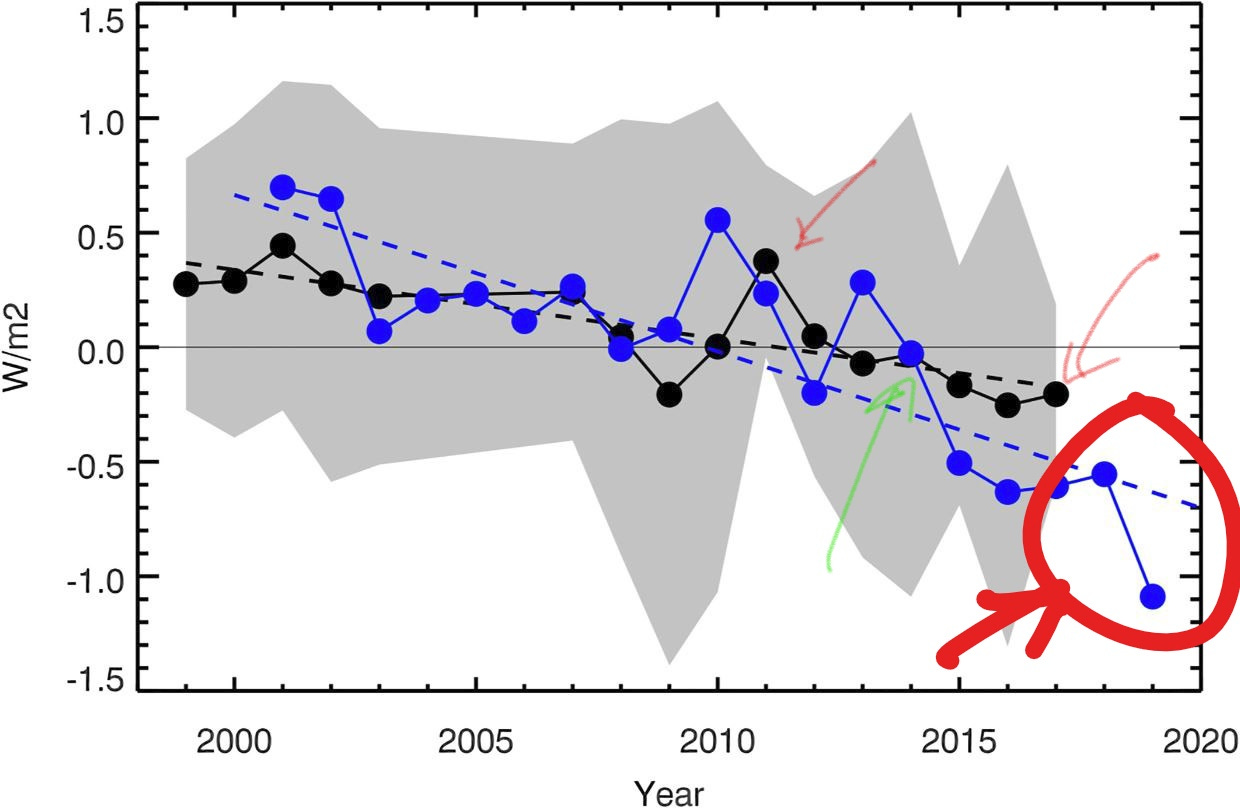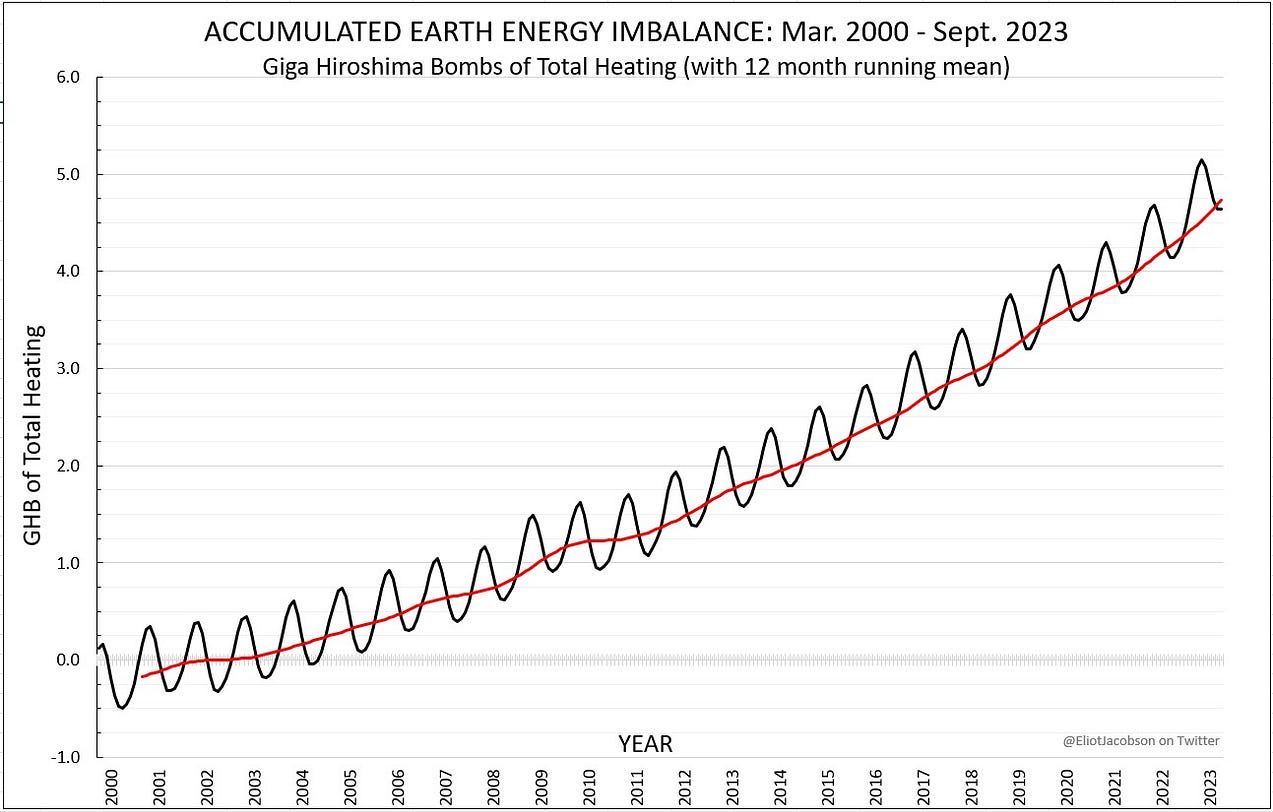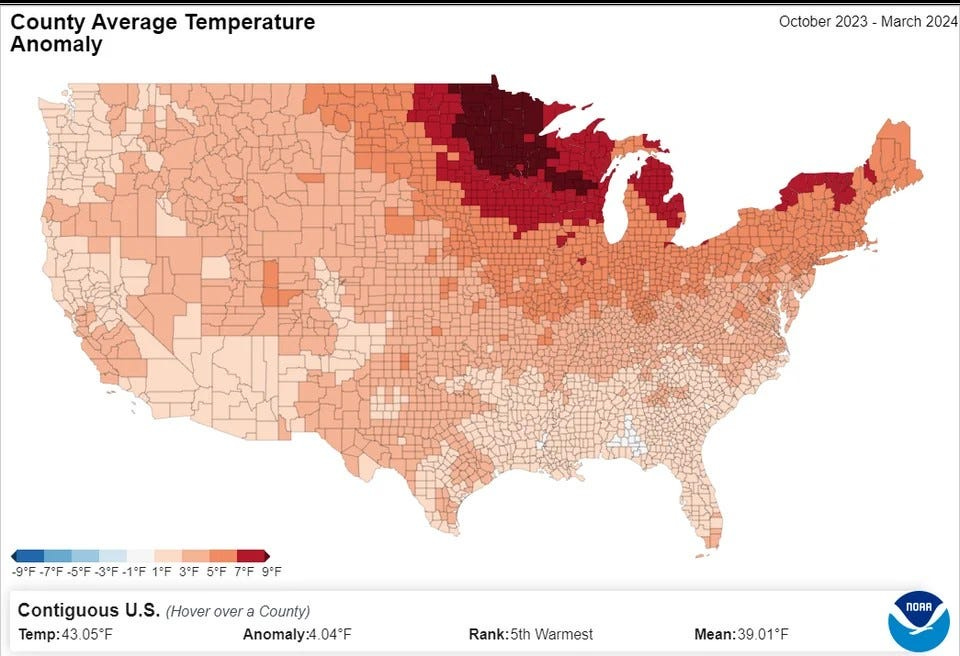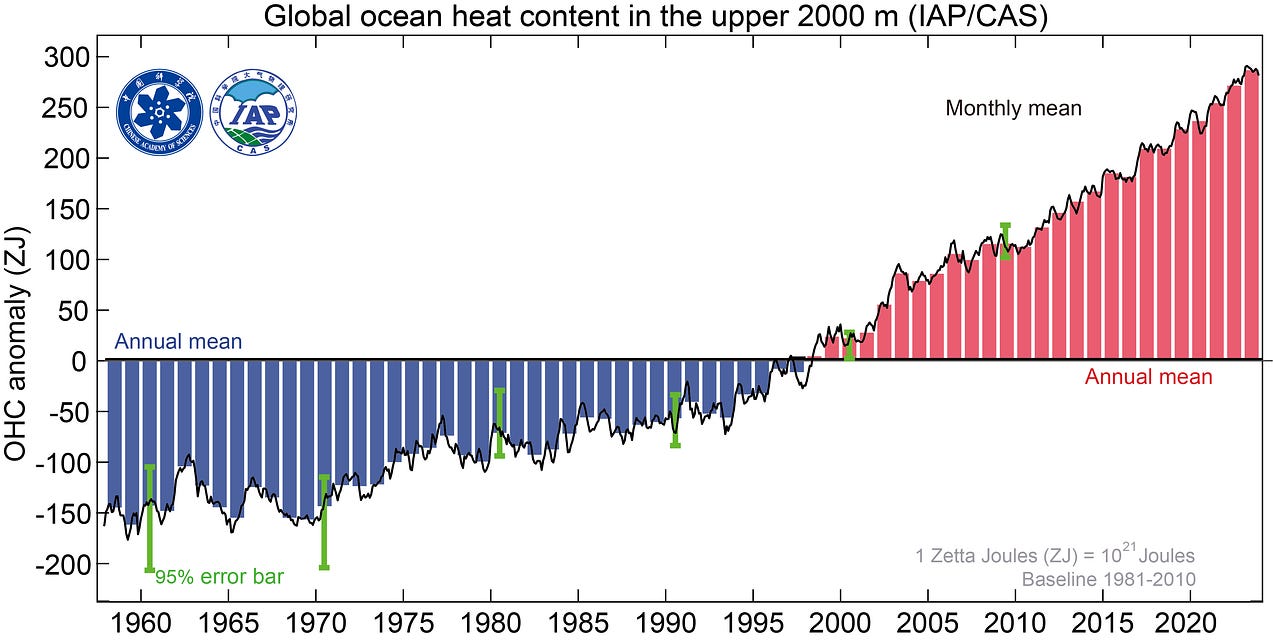Climate Doom Is Out. ‘Apocalyptic Optimism’ Is In. -NYT 04212024
Focusing on disaster hasn’t changed the planet’s trajectory. Will a more upbeat approach show a way forward?
SO, it’s Earth Day again. That “once a year” day when we are supposed to actually give a crap about the environment and the state of the planet. This year people are actually beginning to notice that “something might be wrong”.
Hence this “oh so upbeat” piece in the NYT yesterday.
It starts out with,
“The philanthropist Kathryn Murdoch has prioritized donations to environmental causes for more than a decade. She has, she said, a deep understanding of how inhospitable the planet will become if climate change is not addressed. And she and her colleagues have spent years trying to communicate that.”
“We have been screaming,” she said. “But screaming only gets you so far.”
Which, OK. I COMPLETELY understand and agree with that. What’s your ideas for how to “break through” to people?
“Murdoch and Ari Wallach, an author, producer and futurist, have just released their new PBS docuseries, “A Brief History of the Future”.
This is apparently their “big idea” on how to talk to people about “Catastrophic Climate Change.
Be OPTIMISTIC, HOPEFUL, and DREAMY.
“Shot cinematically, in some never-ending golden hour, the six-episode show follows Wallach around the world as he meets with scientists, activists and the occasional artist and athlete, all of whom are optimistic about the future.”
“An episode might include a visit to a floating village or a conversation about artificial intelligence with the musician Grimes. In one sequence, marine biologists lovingly restore a rehabbed coral polyp to a reef.”
“The mood throughout is mellow, hopeful, even dreamy. Which is deliberate. There’s room for screaming. And there’s room for dreaming.” — Ari Wallach
“A Brief History of the Future” joins some recent books and shows that offer a rosier vision of what a world in the throes, or just past the throes, of global catastrophe might look like.”
Climate optimism as opposed to climate fatalism.
“Hannah Ritchie’s “Not the End of the World: How We Can be the First Generation to Build a Sustainable Planet” argues that many markers of disaster are less bad than the public imagines (deforestation, over-fishing) or easily solvable (plastics in the oceans).”
OMG are the mainstream media pushing this book. MSNBC, Bill Gates, the NYT, CNN. EVERYONE loves her “message of HOPE”.
“Life as We Know It (Can Be),” a book by Bill Weir, CNN’s chief climate correspondent, that is structured as a series of letters to his son, centers on human potential and resilience.
Dana R. Fisher’s “Saving Ourselves: From Climate Shocks to Climate Action” contends that the disruptions of climate change may finally create a mass movement that will lead to better global outcomes. She describes her book as a “data driven manifesto,” and posits a world in which climate shocks become so great that they spur mass protest and force government and industry to transition to clean energy.
“It’s the most realistically hopeful way to think about where we get to the other side of the climate crisis,” she said.
She basically says, “people are SO STUPID” that the only way we will get our shit together is when things start to get bad. So, it’s a GOOD THING that things are getting BAD. Because that means people will finally do something about Climate Change.
“Fisher, a sociologist, coined the term “apocalyptic optimism” to describe a belief that humans can still avoid the worst ravages of climate change.”
“In confronting the apocalypse, these works all insist that hope matters.
“They believe that optimism, however qualified or hard-won, may be what finally moves us to action.”
“The goal for “A Brief History of the Future” wasn’t to ignore climate change or other seam rippers of the social fabric but, in classic Mr. Rogers style, to look to the helpers.”
“There’s a huge amount of focus in the news and storytelling in general on what could go horribly wrong,” Murdoch said. “What I really wanted to highlight was all the work that’s happening right now to make things go right.”
The rest of the article is a discussion of the documentary and Hannah Ritchie’s book with this bit of “gloomy” counterbalance.
“The journalist Jeff Goodell has studied that data. The title of his recent book, “The Heat Will Kill You First: Life and Death on a Scorched Planet,” suggests a more sober perspective.”
“He wanted to use his storytelling, he said, not necessarily to inspire hope or even anger, but to communicate what the planet faces. “Because you can’t talk about solutions until you understand the scope and scale,” he said. He is also skeptical, he said, of much of the sunny, solutions-minded messaging.”
“It makes it feel like climate change is like a broken leg, “ he said. “With a broken leg, you’re in a cast for six or eight weeks. You suffer some pain, then you go back into your old life.” He doesn’t believe that’s the case here.”
“We’re not going to fix this. It’s going to be how do we manage to live in this new world.” — Jeff Goodell
But, as expected, they end on an UPBEAT note.
Imagining a Better Future
“In this sense, hope is a spur, a prod, an uncomfortable goad.”
Imagining a better future is a brave and even necessary act. -Alexis Soloski NYT
“Storytelling — whether through fiction, documentary, data science or sociology, and however optimistic — might seem a limp response to the climate crisis.”
Narrative won’t stop coral bleaching or the leaking of methane from Arctic soil into the atmosphere. But it’s a tool that’s available, cheap and endlessly renewable. And as a society, we will not act on climate change until we’re convinced that our action is useful and urgent.
“In order to build a better world, you need to be able to envision that one is possible.” — Hannah Ritchie
— — — — — — — — —
The PROBLEM with ALL of these books is that they assume we still have DECADES before things get “Truly Awful”. The only one of them who seems to have a clue is Jeff Goodell, and even he is still thinking in terms of a few more decades of gradually worsening climate conditions.
We don't have “a few more decades”.
Here are my APOCALYPSE NUMBERS for this Earth Day.

Start with this.
The Earth’s Albedo is “dimming”.

We have a continuing, and significant negative trend. This means that more solar ENERGY enters the Climate System and warms the Earth.
That the albedo trend is negative is well established, has been demonstrated with different methods: Ceres satellite data, and also by measuring the Earth’s back-radiation towards the Moon.
Earth’s Albedo 1998–2017 as Measured From Earthshine pub. Aug 2021


He stated that,
We would need to cover about 1.6% of the planet with mirrors, placed in the equatorial oceans, to get the Albedo we had in 2001.
Perhaps Hannah Ritchie see’s that as “easily doable”.
The climate is VERY sensitive to a reduced ALBEDO.
Scientists at NASA claim that a reduction in albedo of just -1% produces a warming effect equal to a doubling of CO2 in the atmosphere.
Changes in Earth’s Albedo Measured by Satellite, Wielicki and 5 co-authors, Science 2005, https://doi.org/10.1126/science.1106484
Accordingly, the albedo decrease we have had in the last 24 years corresponds to almost +2.0 W/m². The increase in CO2 corresponds to only 0.7 W/m².
Calculations
1. Forcing from CO2
The IPCC states +3.9 W/m2 increased forcing from a doubling of CO2. Mathematically, we search a factor that gives +3.9 from a doubling, expressed as a logarithm, ln(2/1). That factor is 5.63:
3.9 = x * ln(2/1) è x = 5.63
We can now insert start and end values for CO2 instead of the numbers ‘2’ and ‘1’. In March 2000 we had about 370 ppm and in September 2023 about 420 ppm. The theoretical forcing from CO2 for the period would then be:
5.63 *ln(420/370) = 0.71 W/m²
2. Forcing from albedo decrease
a. Using the data. Estimating the global albedo decrease from March 2000 to September 2023 with OLS yields a negative slope of -0.0019 percentage points (pp) per month, and the total decline for the period is 0.54 pp.
Assuming a linear relationship during the period, a reduced albedo of 0.54 pp gives an increased solar irradiation of:
0.0054 * 340 W/m2 = 1.84 W/m2
b. Using the NASA rule of thumb. Alternatively, calculated according to the NASA researchers’ claimed relationship of the warming effect of a 1 percent albedo reduction mentioned above, and using IPCC:s value for forcing from CO2 of 3.9 W/m2, the theoretical forcing of the global albedo reduction for the 24 years is:
3.9 * 0.0054/0.01 = 2.1 W/m²
Reality Check:

In both variants a. and b., the resulting figure is more than 2.5 as large as the forcing from CO2. The calculations have not taken into account the slightly decreasing solar radiation over time, but this affects the result only marginally.
Conclusion:
The ongoing, long term reduction in albedo has produced more than twice as much warming effect in recent decades as the radiative forcing from CO2.
THIS IS WHERE “THE HEAT” IS COMING FROM.
Letting in more sunlight — Increases the EARTHS ENERGY IMBALANCE.

The EEI is generally discussed in terms of “Watts per square meter” of ENERGY averaged across the entire planet. While the number itself is small, the number of meters is HUGE.
For that reason, a new unit of measure is gaining popularity, “HIROS per second”.
HIROS is short for Hiroshima Bombs worth of ENERGY. It is much stronger in that it conveys more viscerally what these levels of ENERGY translate to in human terms.
It works fairly well in that.
An EEI of +1.5W/m2 equals +15 Hps equals +15 Zetta Joules of HEAT added to the Ocean Heat Content in 2023.

Hansen mentions the ARGO float network often in his most recent papers.

There are now a LOT of them.

Which is the context you need to understand this graph from March 20th 2024.

On March 20th 2024, Dr. Jacobson posted this graph with the note.
“CERES data for Jan. 2024 just came out, and for the first time in over a year, the three-year running mean for the Earth Energy Imbalance (EEI) decreased. That’s right! The EEI fell from 12.99 HpS to 12.95 HpS.”
He’s right to be excited. Because it means the sudden burst of WARMING may be PEAKING.
That would be REALLY Good News.
At least in the sense that it would mean things were stabilizing. Because, the EEI peaking means that temperatures will stop going up. It would mean that Hansen was accurate in his forecast.

Hansen forecast in 2022 that the El Nino would peak at around +1.8C and then temperatures would drop back down to a NEW NORMAL of around +1.5C to +1.6C*.
*Depending on how you measure and which date you start from.

The BAD news would be that the planet isn’t going to cool back down to the +1.2C it was in 2022. It’s going to stay at 2023 levels of warming.
This is just a temporary respite.
Because 90% of the extra ENERGY going into the Climate System is going into the Global Ocean.
Global Warming is Ocean Warming.
All of that extra ENERGY has been going right into the Oceans.
In 2023 the EEI was about +1.85W/m2 by Berkeley Earth’s calculation.
This ENERGY IMBALANCE resulted in +15Zj of HEAT being added to the Global Ocean in a single year.
That’s 471,000,000 Hiros worth of ENERGY added to the Global Ocean in a SINGLE YEAR.

This DOES NOT STOP just because warming has “stabilized”.
At LEAST as much ENERGY will go into the Oceans this year, as last year.
Warming the Planet.
This is how our world looks right now.


Because of Latitudinal Gradient Shift and Polar Amplification MOST of the HEAT that starts at the Equator, is going to wind up at the Poles.
Warming the Poles REALLY FAST.
Because the Arctic is warming a LOT faster than the rest of the Earth.
The Arctic has warmed nearly four times faster than the globe since 1979
Communications Earth & Environment volume 3, Article number: 168 (Aug 2022)
This warming is going to have SEVERE CONSEQUENCES. Ones that we are already seeing.
It’s going to cause the Boreal Forests to BURN.
It has been going on in Siberia.
Last year Canada.
Soon, Alaska.
It’s going to cause the Permafrost to MELT.
This is an APOCALYPTICALLY BAD THING.
Permafrost isn’t a feature, it’s a CARBON BOMB. It has been accumulating organic carbon for +700,000 years.

It’s starting to release it.
Arctic permafrost is now a net source of major greenhouse gases — New Scientist 12 April 2024.
An Arctic-wide survey has found that the permafrost region is emitting more carbon into the atmosphere than it absorbs, causing the planet to heat even further.
This plus the burning forests are going to ADD a LOT of CO2 to the atmosphere over the next 20 years as the Boreal Forests burn away completely.
Increasing the Rate of Warming.

Hansen thinks the current Rate of Warming is about +0.45C per decade. It could be a little higher. We will know more in about 12 to 18 months.
A Rate of Warming of +0.45C means +2C by 2030.
+3C by 2050.
+4C by 2070.
+5C by 2090.
Until the EEI is in “balance” again.
Which at the CO2e level of 530ppm that Hansen calculated in one of his recent papers. Means about +5C to +6C in the paleoclimate record.

So, on this Earth Day. I won’t be engaging in “Apocalyptic Optimism”.
I’ll be enjoying the last few “good years” we have left.
This is my analysis.
This is what I see.
This is my “Crisis Report”.
— rc 04222024
Personal Notes:
Yeah, I kinda missed getting this out on the 22nd. I wrote all day and came in just over the wire.
Que Sera, Sera.















Thanks for writing this. Can you give an explain why EEI will go down?
Any reason why albedo is decreasing?
Once again, thank you for your work!!